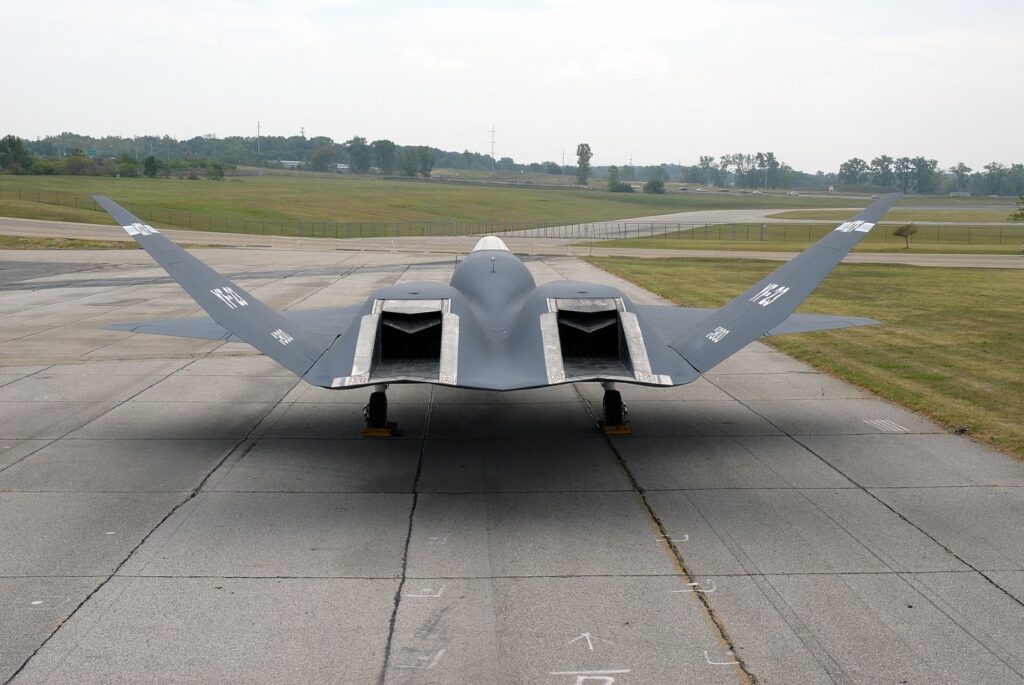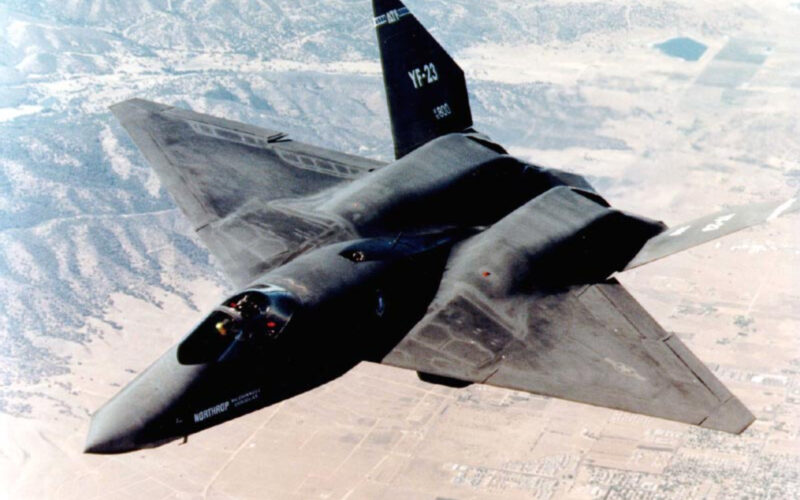In the realm of cutting-edge military aviation, stealth technology has emerged as a crucial aspect of modern warfare. The YF-23 Black Widow, an advanced stealth fighter, stood as a trailblazer in the realm of aerial combat, shaping the future of air superiority, even though it never saw active service.
Here we explore the development, features and significance of the YF-23 Black Widow, a remarkable aircraft that pushed the boundaries of stealth technology.
Origins and development
During the 1980s, the United States Air Force (USAF) initiated the Advanced Tactical Fighter (ATF) program to replace its aging fleet of fighter aircraft.
The proposed aircraft should not only possess low-observable radar characteristics but also demonstrate its ability to outperform the latest Soviet Su-27 Flanker and MiG-29 Fulcrum fighters in dogfight situations. This represented a significant advancement because, up until then, the only existing stealth aircraft, the F-117 Nighthawk, lacked air-to-air weaponry and supersonic flight capability. Additionally, the Air Force desired the ATF to have super-cruise capabilities, enabling sustained supersonic flight without relying on fuel-consuming afterburners.
Two contenders emerged as the finalists in this high-stakes competition: the YF-22, developed by Lockheed Martin, and the YF-23 Black Widow, designed by Northrop Grumman. Lockheed’s YF-22 had a visually impressive design, but the YF-23 truly stood out with its extraordinary appearance. It featured diamond-shaped wings that contributed to reduced radar visibility, and its slim side profile was reminiscent of the iconic SR-71 Blackbird spy plane.
The YF-23 made its first flight on August 27, 1990. Both YF-23 prototypes completed a combined total of 50 flights, accumulating an impressive 65.2 hours of flight time. The tests confirmed that the YF-23 achieved the performance values predicted by Northrop, showcasing superior stealth capabilities and speed.
Despite the YF-23’s remarkable capabilities, the YF-22 won the competition. The YF-22 was equipped with thrust-vectoring capabilities, aiding in executing tight maneuvers at low speeds. Thus, the YF-22 demonstrated better agility and maneuverability, outperforming the YF-23 in flight testing.
Therefore, the YF-23 program got canceled, with only two YF-23s prototypes having been built, and the YF-22 went on to be developed into the F-22 Raptor.
YF-23 Black Widow’s design and stealth features
The YF-23 Black Widow was a revolutionary aircraft designed with stealth in mind. Its unique, faceted shape, angular surfaces, and blended edges were carefully crafted to minimize radar cross-section, ensuring reduced detectability by enemy radar systems. The aircraft’s dark, radar-absorbent material coating further enhanced its stealth capabilities, absorbing and diffusing radar waves in order to prevent them from being reflected back to the source.
To further reduce its infrared signature, the YF-23 featured an innovative cooling system that efficiently dissipated heat generated by its engines. Using a similar system to the B-2 Spirit, a stealth bomber also developed by Northrop Grumman, the exhaust gases were “transpiration cooled” by projecting them on tiles fitted around the nozzles to absorb the heat. This system allowed the aircraft to minimize its thermal emissions, making it less susceptible to infrared-guided missiles.

Performance and avionics
The YF-23 boasted outstanding performance characteristics, including high speed, agility and range. Powered by two advanced turbofan engines, the aircraft was capable of supercruise, meaning it could reach supersonic speeds without the need for afterburners, enabling it to fly faster and consume less fuel than many of its contemporary counterparts, while also reducing its infrared signature. Its high cruising speed and long-range capabilities gave it a significant tactical advantage, allowing it to cover vast distances in shorter time frames.
Among the two constructed aircraft prototypes, the initial YF-23 (PAV-1 “Spider”) was equipped with Pratt & Whitney YF119 engines, while the second one (PAV-2 “Grey Ghost”) utilized General Electric YF120 engines. The prototypes were designed with two turbofan engines, each housed in a distinct engine nacelle featuring S-ducts. These S-ducts were positioned on either side of the aircraft’s spine, serving to protect the engine axial compressors from radar waves.
The YF-23’s cockpit featured state-of-the-art avionics and fly-by-wire technology, providing pilots with improved situational awareness and ease of control. Its advanced radar system allowed for long-range target detection and tracking, ensuring a clear advantage in both air-to-air and air-to-ground engagements.
| Category | Specs |
| Crew | 1 (Single-seat configuration) |
| Wingspan | 43 feet 7 inches (13.28 meters) |
| Length | 67 feet 5 inches (20.55 meters) |
| Height | 13 feet 11 inches (4.24 meters) |
| Empty Weight | 29,000 lbs (13,154 kg) |
| Maximum Takeoff Weight | Approximately 80,000 lbs (36,287 kg) |
| Powerplant | 2 x Pratt & Whitney YF119-PW-100 or General Electric YF12 low-bypass turbofan engines |
| Thrust | 35,000 pounds (160 kilonewtons) |
| Maximum Speed | At high altitudes a speed of Mach 2.2 (1,450 mph or 2,335 km/h) |
| Range | 2,424 nautical miles (2,789 miles or 4,489 kilometers) |
| Service Ceiling | 65,000 feet (20,000 meters) |
| Armament (none were tested but provisions incorporated) | 1 × 20 mm (0.79 in) M61 Vulcan cannon 4 × medium-range air-to-air missiles (AIM-120 AMRAAM or AIM-7 Sparrow) 2 × short-range air-to-air missiles (AIM-9 Sidewinder) |
| Combat range | 651 to 695 nautical miles (749 to 800 miles or 1,206 to 1,287 kilometers) |
Is there a future ahead for the YF-23 Black Widow II?
In late 2004, Northrop Grumman submitted a proposal for a bomber based on the YF-23 to address the USAF’s requirement for an interim bomber. This proposal was in competition with the FB-22 and B-1R concepts. However, in 2016, the Air Force ultimately selected Northrop’s long-range B-21 bomber instead of reviving the YF-23 Black Widow.


